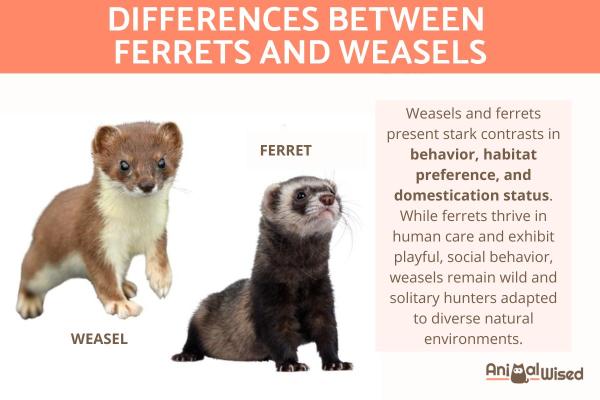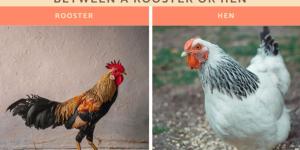Differences Between Ferrets and Weasels


Ferrets and weasels, often mistaken for one another, are both members of the Mustelidae family known for their playful demeanor and curious nature. While they share some physical similarities, they are distinct species with different behaviors, habitats, and needs. Understanding these key differences between ferrets and weasels is essential for appreciating the unique characteristics of each species.
This AnimalWised article delves into the key differences between ferrets and weasels, helping you distinguish them and understand their unique characteristics.
Are ferrets part of the weasel family?
Yes, ferrets are part of the weasel family. In fact, both ferrets and weasels belong to the same subfamily within the weasel family, the Mustelinae, which encompasses a diverse array of carnivorous mammals. This subfamily includes not only ferrets and weasels but also polecats and mink, all of which share common ancestry and certain physiological traits.
While ferrets and weasels share a close family lineage, they do have some distinct differences. These differences range from physical characteristics like size and temperament to their preferred habitats and domestication status.
If you want to know about the Mustelinae family, read on this other article.

General differences between ferrets and weasels
At first glance, ferrets and weasels may appear similar, but upon closer examination, a world of differences emerges in their diet, lifespan, and preferred habitats. Let's delve deeper into these distinctions:
Diet:
- Ferrets: they are primarily meat-eaters, but may occasionally consume other food sources such as plants, fruits, or insects. Some also consume commercially prepared ferret food or raw meat diets with appropriate supplements.
- Weasels: they are obligate carnivores, meaning their diet relies solely on meat. They primarily consume small mammals, insects, and birds.
Life Expectancy:
- Ferrets: in domestic settings, with proper care and nutrition, ferrets can live 5-8 years, with some reaching 10-12. Wild ferrets have a shorter lifespan, averaging 2-4 years due to environmental challenges and predation.
- Weasels: as wild carnivores, weasels face numerous threats, resulting in an average lifespan of 1-3 years.
Habitat:
- Ferrets: primarily found in Europe, Asia, and Africa, their natural habitat varies by species. Some inhabit grasslands, steppes, and forests, while others prefer rocky areas and coasts.
- Weasels: widely distributed across North America, Europe, Asia, and parts of Africa. Their diverse habitats include grasslands, forests, tundra, and mountains.
Physical differences between ferrets and weasels
Ferrets and weasels are often mistaken for one another due to their similar appearance. However, they exhibit distinctive physical characteristics that set them apart. Let's delve deeper into their defining characteristics:
Size:
- Ferrets: ferrets, being domesticated animals, are generally larger than their wild relatives, ranging in length from 18 to 24 inches (45.7 to 61 cm), including the tail. Furthermore, ferrets weigh considerably more, typically between 1.5 to 4 pounds (680 grams to 1.8 kg), with males being larger than females.
- Weasels: the common weasel's body (not including the tail) can range from 4.5 to 10 inches (11.4 to 25.4 cm) in length. The tail can add 1.2 to 4.7 inches (3 to 12 cm). The weight also varies by species, with common weasels weighing between 1.6 to 3.5 ounces (45 to 100 grams).
Tail:
- Ferrets: in contrast, ferrets sport shorter, bushy tails.
- Weasels: possess remarkably longer tails, almost as long as their bodies, contributing to their agile movements.
Coat color:
- Ferrets: primarily display dark brown or black fur, sometimes accented with white or cream markings. Selective breeding has fostered a wider range of colors and patterns in ferrets.
- Weasels: typically exhibit lighter brown or tan fur with a contrasting white underbelly. Their coloration may vary slightly depending on species and season.
Body shape:
- Ferrets: possess a slender, long-bodied build with relatively shorter legs.
- Weasels: exhibit an even sleeker and leaner build with proportionally longer legs, suited for their swift and nimble movements.
Do not miss this other article on how to deal with an aggressive ferret.
Behavioural differences between ferrets and weasels
While ferrets and weasels share ancestry within the Mustelidae family and display some behaviors typical of mustelids, they also present notable differences in their behavioral patterns. Perhaps their most important difference lies in their suitability as pets.
Ferrets, through generations of selective breeding and domestication, have adapted to life alongside humans. With proper care and enrichment, they can thrive in responsible homes.
Weasels, however, retain their wild instincts and solitary nature. Their unpredictable behavior and potential aggression make them unsuitable for domestication, and their needs are best met in their natural habitats.
In addition, there are further differences in behavior, including:
Activity levels:
- Ferrets: diurnal creatures, most active during the day.
- Weasels: typically nocturnal or crepuscular, meaning they're most active at dawn, dusk, and night.
Social nature:
- Ferrets: highly social creatures, often enjoying human interaction and readily forming bonds with their owners. They typically live in family groups in the wild.
- Weasels: solitary animals, mainly interacting with others during mating season. They exhibit territorial behavior and avoid close contact with other individuals.
Temperament:
- Ferrets: they are known for being playful and curious, readily interacting with humans and enjoying enrichment activities.
- Weasels: they are highly independent and wary of humans, displaying strong instincts and potential aggression. In fact, domestication is not recommended due to their wild nature.
Mating:
- Ferrets: they breed seasonally, typically in spring (March-May in Northern Hemisphere).
- Weasels: they breed throughout the year, with peak activity varying by species and location.
Parental care:
- Ferrets: females provide extensive parental care, nursing their young for several weeks and teaching them hunting skills.
- Weasels: parental investment is minimal. In fact, mothers wean their kits quickly and focus on their own survival.
If you want to read similar articles to Differences Between Ferrets and Weasels, we recommend you visit our Facts about the animal kingdom category.
- Myers, P. (2001). "Didelphimorphia ." Animal Diversity Web. Available at: https://animaldiversity.org/accounts/Didelphimorphia/
- Myers, P., R. Espinosa, CS Parr, T. Jones, GS Hammond, and TA Dewey. (2024). The Animal Diversity Web . Available at: https://animaldiversity.org.
- IUCN. (2024). The IUCN Red List of Threatened Species . Version 2023-1. Available at: https://www.iucnredlist.org.






